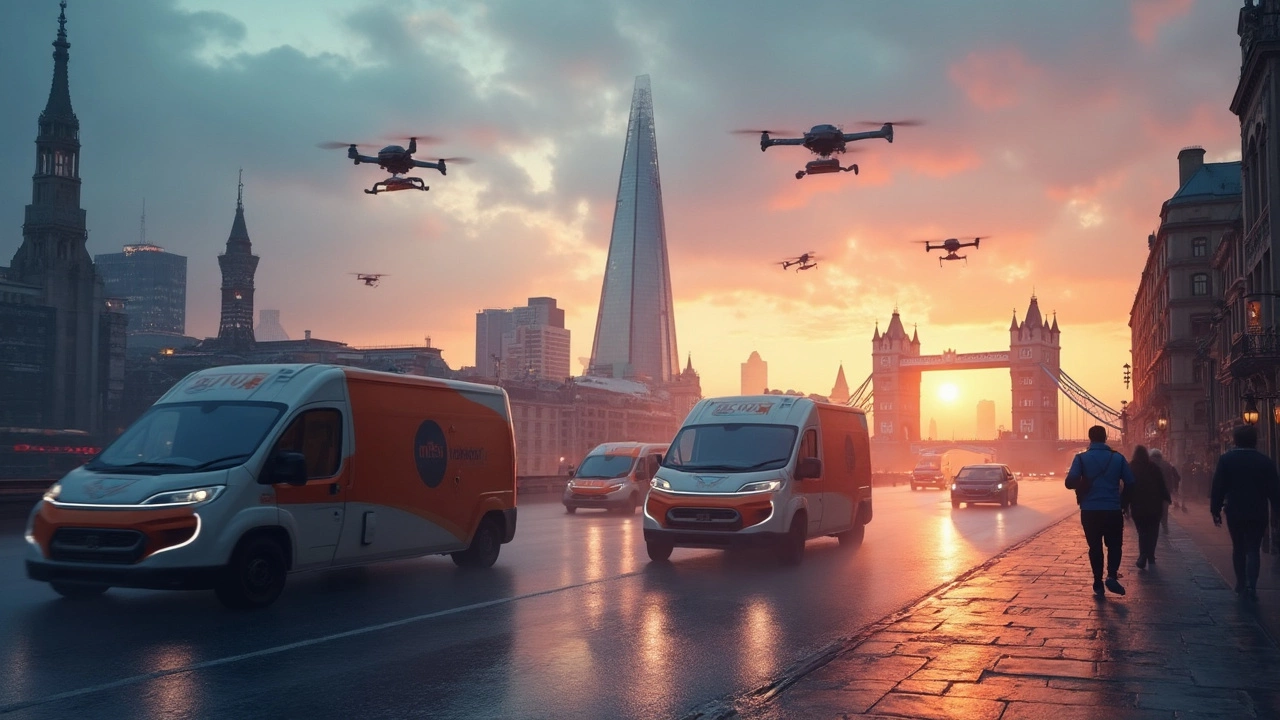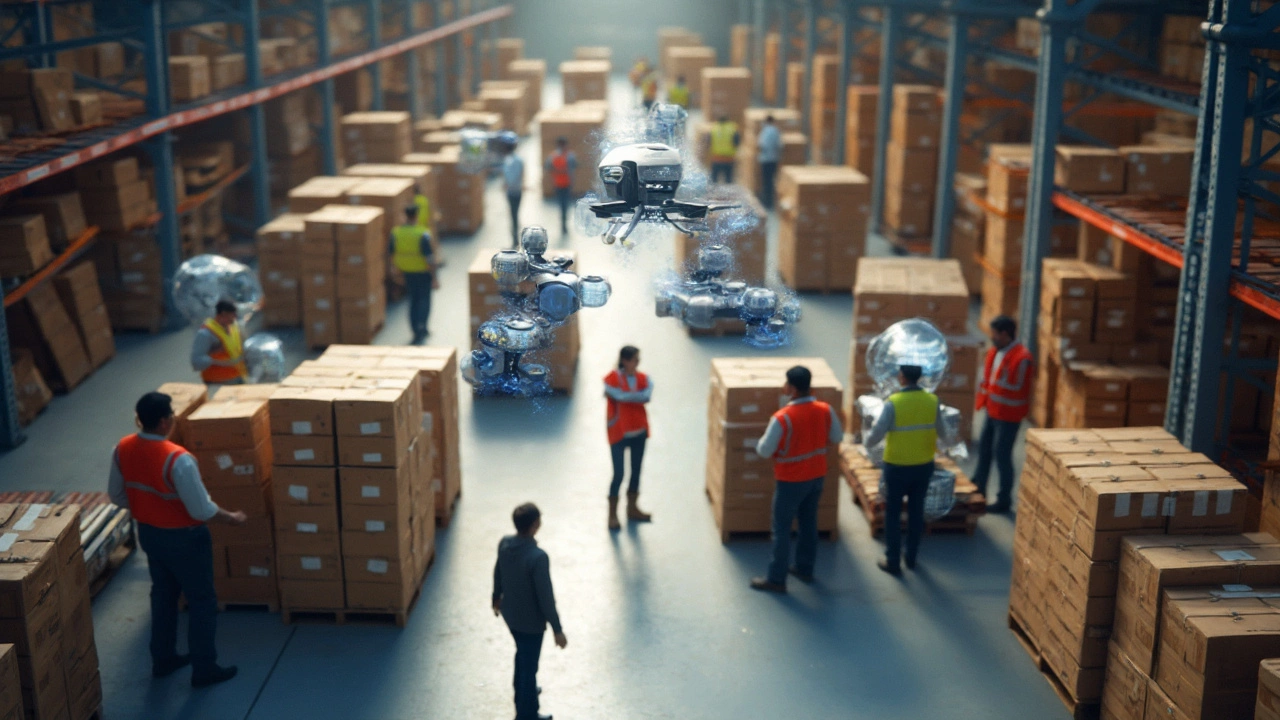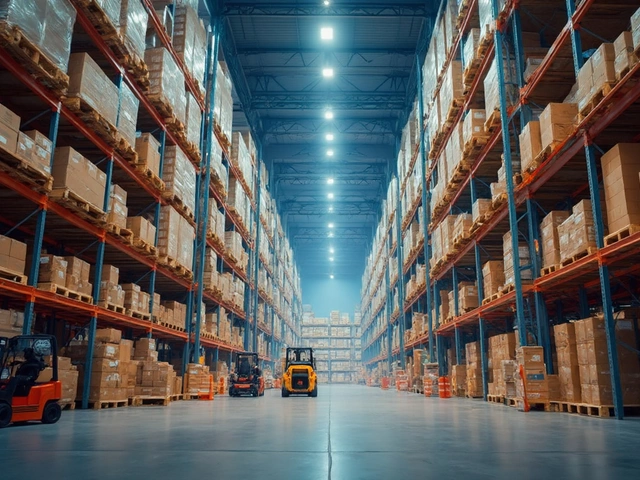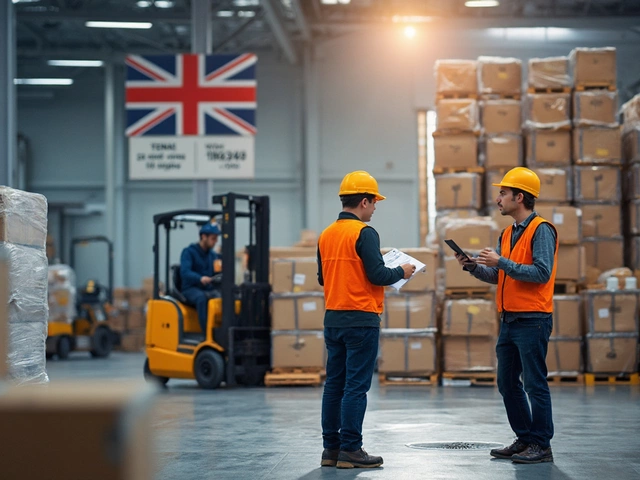We often hear the terms logistics and e-logistics thrown around, especially in the e-commerce world, but what's the real difference? Traditional logistics is all about getting products from point A to point B using various methods like trucks, ships, or planes. It involves managing inventory, transporting goods, warehousing, and handling shipments.
Now, e-logistics takes this basic idea and gives it a tech twist. It leverages digital tools to make the whole process more efficient, faster, and usually a bit less stressful. Think along the lines of automating warehouse operations or using advanced GPS tracking to monitor deliveries. It’s a game-changer, particularly in our online shopping-driven world.
- Traditional Logistics Basics
- E-Logistics Demystified
- The Role of Technology in E-Logistics
- Benefits of Using E-Logistics for E-commerce
- Challenges Faced in E-Logistics
- Future Trends in E-Logistics
Traditional Logistics Basics
When we talk about logistics, we're diving into a field that's as old as trade itself. At its core, logistics is about managing the flow of goods from the manufacturer to the end user. This involves a lot more than just transportation, though that's a big part of it. Think of logistics as the puppet master behind the scenes ensuring that supply and demand meet in harmony.
Core Components of Logistics
The process is made up of several key components:
- Transportation: This is the backbone of logistics, encompassing everything from trucks and trains to ships and planes. It’s all about choosing the most efficient and cost-effective way to move goods.
- Warehousing: Once goods are produced, they need a place to hang out until they're needed. Warehouses store these products safely and securely, often being strategically located to minimize delivery times.
- Inventory Management: Keeping track of all those goods is crucial. This involves maintaining the right balance of stock to meet customer demand without incurring extra costs tied to overstock or stockouts.
- Order Fulfillment: Once an order is placed, logistics ensures it’s processed, packaged, and ready for delivery. This involves coordination between different departments and sometimes multiple vendors.
Everything in logistics is about efficiency and timing. If any part of the chain falters, it can cause delays and added costs to the entire operation.
Challenges in Traditional Logistics
Despite its long history, traditional logistics isn't free of challenges. From handling unexpected delays, like traffic jams and weather disruptions, to dealing with labor strikes and fluctuating fuel prices, there's always something that can go awry. Companies are constantly seeking innovative ways to overcome these hurdles, often by optimizing routes or investing in advanced tracking technologies.
Fun Fact to Consider
Did you know that logistics accounts for about 8% of the world's GDP? Yep, that's how significant it is! It's an industry that not only drives businesses but economies as well.
E-Logistics Demystified
So, what exactly is this buzzword 'e-logistics' all about? To put it simply, e-logistics is the digital backbone of today's e-commerce logistics world. It uses technology to handle the entire journey of a product from warehouse to the customer's doorstep. Think of it as logistics on steroids, where technology does the heavy lifting.
Gone are the days when logistics was just about trucks and warehouses. With e-logistics, we're talking smart inventory systems, real-time tracking, and efficient order management. Companies use sophisticated software to make sure everything runs like clockwork. And for the customers, this means faster, sometimes same-day delivery and real-time updates on their smartphones.
The Magic of Technology
Tech rules the e-logistics game. One popular tool is the Warehouse Management System (WMS), which helps businesses keep track of inventory and optimize the picking and packing process. It cuts down on mistakes and boosts productivity.
Another key element is Transportation Management Systems (TMS). These help plan efficient routes for delivery trucks, reducing fuel costs and transit time. Basically, it makes sure items are at the right place at the right time.
Table: E-Logistics Technologies
| Technology | Purpose |
|---|---|
| WMS | Inventory control |
| TMS | Route optimization |
| Real-Time Tracking | Status updates |
Challenges in E-Logistics
But it's not all smooth sailing. These systems often require significant investments and can be complex to implement. There's also the data privacy concern. As companies gather detailed information to optimize delivery routes, they must ensure personal data remains confidential.
Even with these hurdles, the benefits often outweigh the drawbacks. E-logistics offers not just a competitive edge but can significantly cut costs and improve customer satisfaction.
The Role of Technology in E-Logistics
Technology has transformed e-logistics into a powerhouse for e-commerce logistics. It's not just about moving goods; it's about doing it smarter and faster. Technologies like IoT, AI, and blockchain are making waves and reducing inefficiencies. Imagine knowing where each parcel is at any moment or predicting demand spikes before they happen. That's possible now, thanks to these tech wonders.
One striking aspect of e-logistics is the use of e-logistics platforms that streamline every process. These platforms help manage inventory levels with precision, optimize delivery routes, and enhance supply chain visibility. John Smith, a logistics expert from LogiTech, said,
"With the integration of AI and machine learning, e-logistics has cut down delivery times by up to 20%. This isn't just a win for businesses, but for customers too."
Key Technologies Driving E-Logistics
- Internet of Things (IoT): Sensors track packages in real-time, helping companies monitor conditions like temperature during transit.
- Artificial Intelligence (AI): AI-driven analytics predict demand and optimize routing to ensure faster deliveries.
- Blockchain: Ensures transparency and security in logistics transactions, fostering trust.
These innovations also contribute to sustainability. Companies reduce waste by only producing and transporting what's needed, thanks to precise demand forecasts.
To illustrate the impact, a survey found that 80% of firms that adopted advanced technology in logistics reported significant cost savings in their supply chain operations. Undoubtedly, as e-logistics continues to evolve, it'll only get better with technology leading the way.

Benefits of Using E-Logistics for E-commerce
In the whirlwind world of online shopping, e-logistics stands out as a super essential piece of the puzzle. Why? Because it brings a bunch of perks that make managing an e-commerce logistics operation smoother, faster, and overall better.
Speed and Efficiency
First up, let’s talk speed. With e-logistics, you can automate lots of boring manual tasks. Think of inventory management with a digital twist, meaning you always know what you’ve got in stock. Plus, things like faster order processing and better shipment tracking are a reality. No more playing the ‘where's my package?’ guessing game.
Better Customer Experience
Ever been stuck waiting ages for a package? Exactly. That's where e-logistics steps in to save the day, helping brands deliver quicker and keep customers happy. You’ve got real-time updates, precise delivery times, and easily accessible customer service lines which are integral in the fierce e-commerce game.
Cost-Effective Solutions
Cutting costs where you can without chopping quality is the dream, right? Well, e-logistics can help track and optimize delivery routes, lowering transport costs. Plus, with cool tech like AI and data analytics, businesses can predict demand and reduce costly storage issues.
- Real-time data adds brainpower to the decision-making.
- Automation reduces labor costs.
- Data insights make demand forecasting easier.
Reach and Scalability
Expanding your market reach is another huge plus. With e-logistics, you’re not just stuck shipping locally. Automation and digital platforms help you plan better, grow faster, and enter new markets without a hitch.
| Feature | Traditional Logistics | E-Logistics |
|---|---|---|
| Tracking | Manual updates | Real-time tracking |
| Inventory | Manual counts | Automated systems |
| Delivery Speed | Standard | Optimized routes |
Overall, for those in the logistics and e-logistics sectors, going digital isn't just a tactical chain-management technique anymore, it's about holding a competitive edge and meeting the fast-paced demands that customers now expect. If you're running an e-commerce gig and haven't dipped your toes into the world of e-logistics yet, it might be time!
Challenges Faced in E-Logistics
While e-logistics offers countless benefits, it certainly doesn't come without its hurdles. First off, there's the issue of technology integration. Many businesses still juggle outdated systems with new digital solutions, making it tricky to get everything running seamlessly. This mishmash can cause data errors and inefficiencies that slow down the whole supply chain.
Scalability Concerns
Another biggie is scalability. As e-commerce booms, the demands on e-logistics systems grow rapidly. Companies struggle to expand their infrastructure fast enough to handle increased volume, especially during peak shopping seasons like Black Friday. Scaling up isn’t just about having more trucks; it involves beefing up warehouses, tech systems, and workforce too.
Last-Mile Delivery Issues
Then, there's the notorious last-mile delivery problem. Getting packages from distribution hubs to customers' doorsteps is often the priciest and most complex part of the journey. Traffic congestion, delivery time slots, and failed deliveries all play a role in complicating last-mile logistics.
Data Security
Data plays a crucial role in e-logistics, but it also poses a security risk. With sensitive customer information and business data being exchanged digitally, companies are at risk of cyber-attacks and data breaches. Ensuring robust cyber defenses is a must.
Environmental Concerns
Last but not least, there's a growing focus on sustainability. With increasing awareness of environmental impact, businesses are under pressure to develop greener logistics strategies. This might mean adopting electric vehicles, optimizing delivery routes to cut emissions, or rethinking packaging practices.
Overcoming these challenges requires innovation and constant adaptation, but for those willing to tackle them, the rewards in the world of e-commerce logistics can be immense.
Future Trends in E-Logistics
As we zoom into the future, the world of e-logistics is on the brink of exciting changes, driven by rapid tech advances. One major trend is the rise of automation. Imagine warehouses filled with robots picking and packing items efficiently and accurately. This isn’t sci-fi—it's the future. Companies like Amazon are already setting the pace.
Another fascinating development is the use of drones for deliveries. While a drone delivering your package sounds like something from a movie, it's becoming a reality. Companies are exploring ways to provide faster, contactless delivery, especially in congested urban areas.
AI and Machine Learning
AI isn't just transforming e-logistics; it's revolutionizing it. Integrating AI and machine learning into logistical operations helps firms predict demand more accurately, minimize delivery times, and optimize routes. These algorithms even learn from past deliveries, meaning they get smarter and more efficient over time.
Additionally, sustainability is a growing concern in e-commerce logistics. Many companies are adopting greener practices, like using electric delivery trucks or eco-friendly packaging, to reduce their carbon footprint.
| Year | Drone Packages Delivered |
|---|---|
| 2023 | 50,000 |
| 2024 | 120,000 |
Lastly, the concept of smart cities will be tightly interwoven with e-logistics. With the use of IoT devices, data sharing across different platforms allows for streamlined operations and enhanced efficiency.
The rise of e-logistics is not just changing how e-commerce businesses operate but how we, as consumers, perceive and interact with delivery services. It's an exciting time, with technology bridging the gap between traditional practices and futuristic possibilities.





